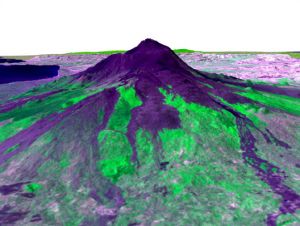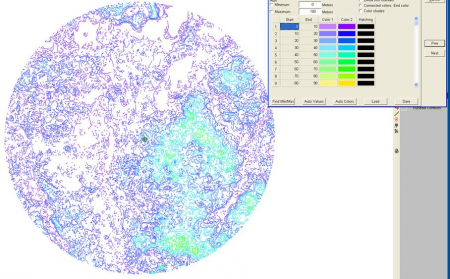Aster Global Digital Elevation Model: Difference between revisions
m (Minor spellings) |
|||
| (9 intermediate revisions by one other user not shown) | |||
| Line 1: | Line 1: | ||
[[Category:Online Data]][[Category: Digital Elevation Models]] | [[Category:Online Data]][[Category: Digital Elevation Models]] | ||
[[File:AsterMountEtna.jpg|right|thumb|NASA / Aster image draped over terrain model of Mount Etna]]The Aster (Advanced Spaceborne Thermal Emission and Reflection Radiometer) Global Digital Elevation Model - or | [[File:AsterMountEtna.jpg|right|thumb|NASA / Aster image draped over terrain model of Mount Etna]]The Aster (Advanced Spaceborne Thermal Emission and Reflection Radiometer) Global Digital Elevation Model - or Aster GDEM for short - is a joint US and Japanese effort. It is based on data from sensors on board on the NASA Terra satellite launched in 1999. The first release of the Aster GDEM dataset was in June 2009. | ||
== Data Coverage == | == Data Coverage == | ||
| Line 7: | Line 7: | ||
== Availability in WindPRO == | == Availability in WindPRO == | ||
Currently, the dataset is not included with WindPRO, primarily because the data license does not allow redistribution of the raw data. | Currently, the dataset is not included with WindPRO, primarily because the data license does not allow redistribution of the raw data. | ||
However, you may choose to manually download the source | However, you may choose to manually download the source DEMs yourself and then import them into WindPRO. | ||
== Data Evaluations == | == Data Evaluations == | ||
Unfortunately the dataset is not of a very good quality. Possibly, this seems to be | Unfortunately the dataset is not of a very good quality. Possibly, this seems to be an inherent problem with the data collection method rather than a data-processing problem. If this is the case, then we might not expect a ‘better’ release of the dataset. Typically the data is polluted with many artifacts and artificial spikes, rendering them highly questionable for wind energy purposes. A spike typically rises about 50-100 m from the general terrain. | ||
As seen from the pictures here - where Aster GDEM and SRTM 90 m data are compared - then the Aster GDEM data is much more 'noisy', even if the ASTER data is made by a 30 m grid as opposed to the SRTM 90 m grid. Below you can see two | As seen from the pictures here - where Aster GDEM and SRTM 90 m data are compared - then the Aster GDEM data is much more 'noisy', even if the ASTER data is made by a 30 m grid as opposed to the SRTM's 90 m grid. Below you can see two DEMs from a Danish site near Skive (about 75 km west from Aalborg). Contours are generated from the original raw grid files using WindPRO with a 5 m equidistance. | ||
{| | {| class="wikitable" | ||
| | |+ align="bottom"|DHM's at Skive, Denmark. Left: Aster GDEM. Right: SRTM data (click the pictures to enlarge). | ||
| | | [[File: AsterSkive.png|450px]] | ||
| | | [[File: SrtmSkive.png|450px]] | ||
| | |} | ||
Other authors have reported simmilar issues. | |||
Jonathan de Ferranti of [http://www.viewfinderpanoramas.org http://www.viewfinderpanoramas.org] has published a study on ASTER GDEM data it is available here [http://www.viewfinderpanoramas.org/reviews.html#aster http://www.viewfinderpanoramas.org/reviews.html#aster] | |||
== Download of ASTER GDEM data == | == Download of ASTER GDEM data == | ||
Latest revision as of 13:10, 6 June 2013

The Aster (Advanced Spaceborne Thermal Emission and Reflection Radiometer) Global Digital Elevation Model - or Aster GDEM for short - is a joint US and Japanese effort. It is based on data from sensors on board on the NASA Terra satellite launched in 1999. The first release of the Aster GDEM dataset was in June 2009.
Data Coverage
The Aster GDEM dataset has a 30 m resolution with a 99% global coverage. However, the current version of the dataset is marked as ‘research grade’, and is reported to contain serious artifacts and spikes.
Availability in WindPRO
Currently, the dataset is not included with WindPRO, primarily because the data license does not allow redistribution of the raw data. However, you may choose to manually download the source DEMs yourself and then import them into WindPRO.
Data Evaluations
Unfortunately the dataset is not of a very good quality. Possibly, this seems to be an inherent problem with the data collection method rather than a data-processing problem. If this is the case, then we might not expect a ‘better’ release of the dataset. Typically the data is polluted with many artifacts and artificial spikes, rendering them highly questionable for wind energy purposes. A spike typically rises about 50-100 m from the general terrain.
As seen from the pictures here - where Aster GDEM and SRTM 90 m data are compared - then the Aster GDEM data is much more 'noisy', even if the ASTER data is made by a 30 m grid as opposed to the SRTM's 90 m grid. Below you can see two DEMs from a Danish site near Skive (about 75 km west from Aalborg). Contours are generated from the original raw grid files using WindPRO with a 5 m equidistance.

|

|
Other authors have reported simmilar issues.
Jonathan de Ferranti of http://www.viewfinderpanoramas.org has published a study on ASTER GDEM data it is available here http://www.viewfinderpanoramas.org/reviews.html#aster
Download of ASTER GDEM data
You may download the data from the Aster GDEM site at:
External Links
- More information on ASTER data is available from NASA / Jet Propulsion Laboratory at http://asterweb.jpl.nasa.gov/